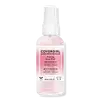What's inside
What's inside
 Key Ingredients
Key Ingredients

 Benefits
Benefits

 Concerns
Concerns

No concerns
 Ingredients Side-by-side
Ingredients Side-by-side

Water
Skin ConditioningDipropylene Glycol
HumectantButylene Glycol
HumectantGlycerin
HumectantAloe Barbadensis Leaf Water
MaskingCentella Asiatica Extract
CleansingSaccharomyces Lysate Extract
HumectantYeast Extract
Skin ConditioningCaffeine
Skin ConditioningTrehalose
HumectantTocopheryl Acetate
AntioxidantSucrose
HumectantSorbitol
HumectantDisodium EDTA
Potassium Sorbate
PreservativeChlorphenesin
AntimicrobialPhenoxyethanol
PreservativeWater
Skin ConditioningGlycerin
HumectantButylene Glycol
HumectantRosa Centifolia Flower Water
Skin ConditioningHydroxyacetophenone
AntioxidantPolysorbate 80
Emulsifying1,2-Hexanediol
Skin ConditioningCaprylyl Glycol
EmollientCocos Nucifera Fruit Juice
EmollientOpuntia Ficus-Indica Fruit Water
Antioxidant3-O-Ethyl Ascorbic Acid
Skin ConditioningTrisodium Ethylenediamine Disuccinate
Citric Acid
BufferingParfum
MaskingCitrus Reticulata Fruit Extract
Skin ProtectingSodium Benzoate
MaskingPotassium Sorbate
PreservativeCI 14700
Cosmetic ColorantWater, Glycerin, Butylene Glycol, Rosa Centifolia Flower Water, Hydroxyacetophenone, Polysorbate 80, 1,2-Hexanediol, Caprylyl Glycol, Cocos Nucifera Fruit Juice, Opuntia Ficus-Indica Fruit Water, 3-O-Ethyl Ascorbic Acid, Trisodium Ethylenediamine Disuccinate, Citric Acid, Parfum, Citrus Reticulata Fruit Extract, Sodium Benzoate, Potassium Sorbate, CI 14700
 Reviews
Reviews

Ingredients Explained
These ingredients are found in both products.
Ingredients higher up in an ingredient list are typically present in a larger amount.
Butylene Glycol (or BG) is used within cosmetic products for a few different reasons:
Overall, Butylene Glycol is a safe and well-rounded ingredient that works well with other ingredients.
Though this ingredient works well with most skin types, some people with sensitive skin may experience a reaction such as allergic rashes, closed comedones, or itchiness.
Learn more about Butylene GlycolGlycerin is already naturally found in your skin. It helps moisturize and protect your skin.
A study from 2016 found glycerin to be more effective as a humectant than AHAs and hyaluronic acid.
As a humectant, it helps the skin stay hydrated by pulling moisture to your skin. The low molecular weight of glycerin allows it to pull moisture into the deeper layers of your skin.
Hydrated skin improves your skin barrier; Your skin barrier helps protect against irritants and bacteria.
Glycerin has also been found to have antimicrobial and antiviral properties. Due to these properties, glycerin is often used in wound and burn treatments.
In cosmetics, glycerin is usually derived from plants such as soybean or palm. However, it can also be sourced from animals, such as tallow or animal fat.
This ingredient is organic, colorless, odorless, and non-toxic.
Glycerin is the name for this ingredient in American English. British English uses Glycerol/Glycerine.
Learn more about GlycerinPotassium Sorbate is a preservative used to prevent yeast and mold in products. It is commonly found in both cosmetic and food products.
This ingredient comes from potassium salt derived from sorbic acid. Sorbic acid is a natural antibiotic and effective against fungus.
Both potassium sorbate and sorbic acid can be found in baked goods, cheeses, dried meats, dried fruit, ice cream, pickles, wine, yogurt, and more.
You'll often find this ingredient used with other preservatives.
Learn more about Potassium SorbateWater. It's the most common cosmetic ingredient of all. You'll usually see it at the top of ingredient lists, meaning that it makes up the largest part of the product.
So why is it so popular? Water most often acts as a solvent - this means that it helps dissolve other ingredients into the formulation.
You'll also recognize water as that liquid we all need to stay alive. If you see this, drink a glass of water. Stay hydrated!
Learn more about Water